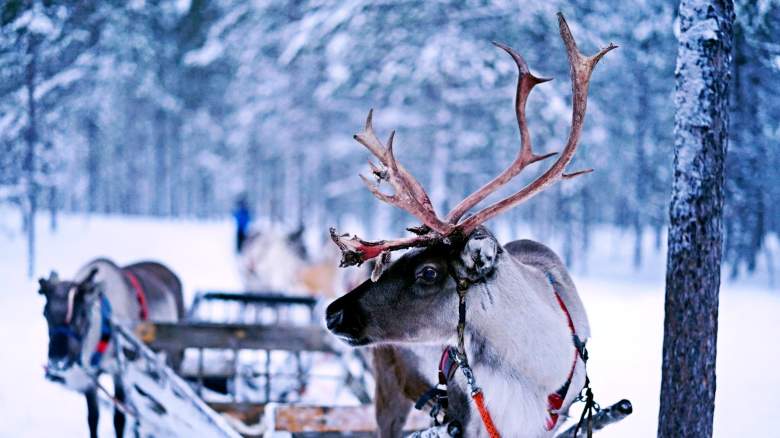
Santa’s sleigh is famously pulled by eight reindeer, nine if you include the luminous Rudolf who pitches in when it’s foggy. The classic eight are Dasher, Dancer, Prancer, Comet, Cupid, Donner, Vixen and Blitzen. Those last two are an easy-on-the-ear translation of Dutch, but the whole eight sound like a fun stag party.
The consequences of most intercontinental flights aren’t so jolly, though. Air travel is a significant contributor to climate change – one ticket on a return flight from London to San Francisco is thought to emit enough carbon to melt five square metres of Arctic sea ice. For Father Christmas, this adds extra stress to Christmas preparations: are reindeer an environmentally friendly form of transport? To answer this question, we need to understand how reindeer spend the rest of the year.
The trouble for Santa is that reindeer are ruminants: they eat plants that ferment and produce methane in their guts – a potent greenhouse gas. But while reindeer are grounded, they nibble small shrubs, and this grazing has a significant effect on the carbon budget of the Arctic landscape.
A recent study from the Norway-Finland border compared the soil fungi in areas subject to year-round grazing by reindeer with places where reindeer only graze during the winter (presumably except for Christmas Eve). Winter-only grazing allowed birch woodland to spread across the tundra. But places with year-round nibbling by reindeer had more heathland vegetation. The fertile soils created by birch, and the species of fungi that live in the soils below the trees, released more carbon. But the more specialist fungi of the heathland soil work more slowly, allowing carbon stocks to build.
The reindeer were credited with holding back birch woodland, whose spread liberates carbon from the soil. Reindeer grazing controls whether the local tundra becomes more forested and loses carbon, or remains covered in dwarf shrubs that hold onto carbon in the soil more securely. This would surely more than offset their methane burps, making reindeer carbon-negative.
But There’s a Catch
Incidentally, birch woodlands are just the place to find the fly agaric toadstool Amanita muscaria: the classic cartoon fungi that look like a bright red cushion artfully flecked with popcorn.
Reindeer who eat the mushroom are reported to run around in circles, making strange noises and twitching, a commonplace Yuletide event in my experience, but in this case due to the effects of the mushrooms’ psychoactive toxins. Some reindeer herders are even credited with drinking the urine from reindeer who have eaten the mushroom. This mulled concoction retains the hallucinogenic effects of the fungi while losing the toxicity.
Unfortunately, what goes in at one end of the reindeer may still cause carbon budget problems when it comes out the other end. A second study from 2021 in north-east Finland showed that reindeer droppings deposited on the bogs and fens they graze in summer can markedly increase the peatlands’ production of methane.
The process seems to result directly from methane-making microbes that have hitched a ride from the reindeer’s rumen (essentially the first chamber of the stomach, a fermentation chamber where microbes help digest the reindeer’s food) and plopped onto the peatlands, adding to the existing microbial life.
The methane-making bacteria in the droppings include species not usually found in the fens, so reindeer droppings inoculate the fen soils with additional methane-producing power. Cattle or muskox cowpats are thought to do something similar, which might explain increased methane production from Arctic soil where these animals graze. Since Santa relies on neither of those heftier bovines, we’ll let them be for now.
The attitude of reindeer to the problem remains mysterious, but we shouldn’t blame them. Reindeer are really Santa’s co-workers in the Christmas night drama, but animals don’t enjoy the same labour protections reserved for human workers. If that isn’t enough to make you put out more carrots, I don’t know what is.![]()
By Mike Jeffries, Associate Professor, Ecology, Northumbria University, Newcastle
This article is republished from The Conversation under a Creative Commons license. Read the original article.